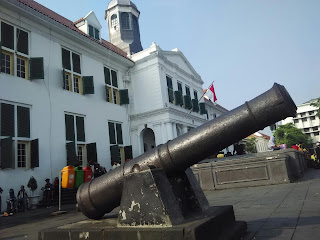The Jakarta Old Town area is located in the northern part of Jakarta. This area is a special district covering an area of 1.3 square kilometers. In 1972, the Governor of Jakarta, Ali Sadikin, issued a decree officially designating the Old Town as a heritage site. The governor's decision aimed to preserve the city's architectural history, or at least the remaining buildings there.
Old Town History
The history of the Old Town dates back to 1526 when Fatahillah was sent by the Demak forces to attack the Hindu kingdom of Padjadjaran through the Sunda Kelapa port, later renamed Jayakarta. Subsequent recorded history in 1619 saw the Dutch East India Company, led by Governor General Jan Pieterszoon Coen, destroy Jayakarta and rename it Batavia.
Batavia was also dubbed the "Pearl of Asia" and the "Queen of the East" in the 16th century by European sailors. Old Jakarta was considered a trading hub for the Asian continent due to its strategic location and abundant resources. The referenced port was Sunda Kelapa Port, initially constructed with a canal measuring 810 meters during its early development. Later, under Dutch rule in 1817, it was expanded to 1,825 meters.
The term "Batavia" itself is derived from the word "Batavieren," the ancestors of the Dutch people. The inhabitants of Batavia were called "Batavianen," later known as the "Betawi" tribe, consisting of creole ethnicities descended from various groups residing in Batavia. The name Batavia was used by the Dutch for over 300 years before it was changed to Jakarta.
Within the Old Town area, there is a spot that has become a favorite gathering place for visitors. This spot is the location of a large cannon commonly known as Si Jagur. The reason for its popularity is its unusual size, reaching up to three meters, three to four times larger than regular cannons.
Si Jagur's distinctive rear shape has puzzled and amused many people because its decoration resembles folded fingers, often misinterpreted as negative. Many believe that the finger ornament has a pornographic symbol, which is not the case at all. Looking at its history, it turns out that the Portuguese, who once occupied Batavia, clung to superstitions, even though they were also religious. They used to cover all openings when going out at night, including the gaps between their fingers, to prevent the entry of evil spirits believed to enter through the body's openings. Some also say that the folded finger symbol is called "fico" in Portuguese, meaning "good luck" or "may you be lucky." Even today, in some Latin American and Portuguese regions, this symbol is still used.
Si Jagur is originally a Portuguese cannon from Malacca captured by the Dutch. Reportedly, Si Jagur was made from 14 cannons, their metal fused into one, and transported to Batavia in 1641 to strengthen the city's defense.
Dasaad Musin Concern
Not far from Fatahillah Park, there stands an old building that is neglected and almost in ruins. Not much is known about this building. On one side, there is an inscription that reads "Dasaad Musin Concern," and in front is displayed "Dasaad Musin Building." The building appears authentic, visibly worn by time, and on the brink of collapse.
The original owner of this building was Agus Musin Dasaad (born in the Philippines on August 25, 1905 – died on November 11, 1970, at the age of 65). He was a conglomerate during the early years of the Republic of Indonesia. Dasaad was the son of entrepreneurs from Menggala, Lampung (father), and Moro, the Philippines (mother). A self-taught individual, he developed his business from scratch. He owned Dasaad Musin Concern, a conglomerate holding licenses for several European and Japanese car brands, as well as a textile factory with the brand Kancil Mas. In the 1930s, Dasaad also ventured into shipbuilding and later became an importer of manufacturing equipment (source: Wikipedia).
Greetings from Travel Indonesia.
Maps Old Country Jakarta
" WELCOME TO INDONESIA "
Support This Blog To Continue Working And Have A Positive Impact On The World - Click to



